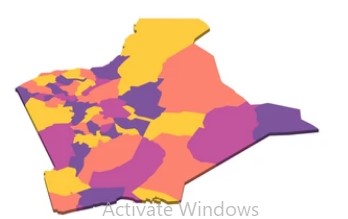
Honorable PCS Mudavadi
Prime Cabinet Secretary Musalia Mudavadi, in his capacity as the acting Interior Cabinet Secretary, has officially gazetted 27 new sub-counties in Kenya 2024 in a move aimed at enhancing government service delivery and addressing security concerns. This landmark decision, part of a broader administrative restructuring, aims to respond to the challenges posed by rapid population growth and the need to align with the government’s 2:1 ratio requirement for administrative units.

New Sub-Counties in Kenya 2024: Key Developments
As of November 2024, Mudavadi has announced the establishment of 578 new administrative units in the country. This includes 27 new sub-counties, 59 divisions, 170 locations, and 322 sub-locations. These additions, which span 31 counties, are part of an ongoing effort to decentralize services and improve accessibility for citizens in even the most remote areas. The establishment of these new sub-counties in Kenya 2024 is particularly significant for enhancing public access to government services and improving security management.
The authorities will distribute the new sub-counties across the country, with some already renaming them to better reflect local needs and developments.. Among the newly gazetted sub-counties are Magarini South, Magarini North, Akachiu, Maua, Tharaka West, and Samburu West. Additionally, authorities will split the districts of Embakasi East, Embakasi West, and Embakasi North in Nairobi into new sub-county units.These changes aim to bring government services closer to the people, reducing the time and distance needed to access essential services.
Impact of the New Sub-Counties in Kenya 2024 on Government Service Delivery
The creation of 27 new sub-counties in Kenya 2024 will significantly impact how the government delivers services. According to the notice released by Mudavadi, once these units are operational, they will streamline service provision across the affected regions. Citizens will benefit from more localized government offices, improving response times and efficiency in service delivery.
Additionally, the creation of these new sub-counties will also enhance security management at the local level. As part of the move, authorities also gazetted new divisions, locations, and sub-locations to improve coordination for security personnel. Administrative officers including County Commissioners, Sub-County Commissioners, Chiefs and Assistant Chiefs will play a crucial role in overseeing the new units, ensuring that local security challenges are promptly addressed.
Reasons for Establishing New Administrative Units
The decision to gazette the new sub-counties is a direct response to Kenya’s growing population, which has placed pressure on existing administrative boundaries. Mudavadi emphasized that the new units would help the government meet the 2:1 ratio for service delivery coordination. This ratio ensures that there is an adequate number of administrative units for each region based on its population size, allowing for effective governance and service delivery.
Moreover, the creation of new sub-counties in Kenya 2024 highlights the government’s continued commitment to decentralizing services, ensuring that even remote areas have improved access to public resources.. Additionally, the restructuring also addresses the need for improved local governance and security, particularly in areas that have historically faced challenges due to large administrative zones.

New Sub-Counties and Their Locations
The new sub-counties gazetted by Mudavadi include areas in both rural and urban settings, ensuring that citizens across different regions will benefit from this expansion. Some of the notable new sub-counties include:
- Magarini South and Magarini North in Kilifi County, which were established to improve access to services in these growing regions.
- Akachiu and Maua, which were restructured from Igembe South to address local governance needs in Meru County.
- Tharaka West in Tharaka Nithi, renamed from the original sub-county to enhance coordination in this mountainous area.
- Samburu West and Samburu East, which will benefit from more focused administrative oversight to address local development and security needs.
In Nairobi, a significant shift occurred as Embakasi East, Embakasi West, and Embakasi North were all separated into new sub-counties. Previously part of the larger Embakasi sub-county, these areas have now been reorganized to better manage the growing population and increased demand for services in Nairobi’s eastern regions.
Administrative Changes in Kenya’s Counties
The reorganization of administrative units has affected 31 counties, improving service delivery and addressing administrative gaps. Some of these counties are already experiencing the positive effects of these changes, including improved security coordination and easier access to government services.
Mudavadi’s decision follows earlier announcements made in February by former Interior CS Kithure Kindiki, who created new sub-counties, divisions, and locations to decentralize services further. The earlier changes laid the groundwork for the more recent gazetting of 578 new administrative units across the country. Local leaders and citizens alike have widely welcomed this move, seeing it as an essential step toward improving governance at the grassroots level.
The Future of New Sub-Counties in Kenya
The establishment of 27 new sub-counties in Kenya 2024 marks just the beginning of an ongoing process of administrative restructuring aimed at improving public service delivery and governance. Authorities will continue efforts to enhance local infrastructure, promote security, and ensure that every citizen, regardless of location, can easily access essential government services.
Authorities will integrate the new sub-counties into the national administrative system and allocate additional resources to ensure these units function efficiently. The National Administration Officers who oversee these regions will play a crucial role in ensuring the success of these changes, particularly in enhancing security and providing public services effectively.
Conclusion
The gazetting of 27 new sub-counties in Kenya 2024 marks a significant development aimed at enhancing governance and service delivery nationwide. These new units, along with the accompanying divisions, locations, and sub-locations, will help address the challenges posed by population growth and enhance security in local communities. As these administrative changes take effect, Kenyans can expect improved access to government services, more localized management, and enhanced security in their regions.
The creation of new sub-counties represents a step toward more inclusive and efficient governance, ensuring that Kenya’s expanding population receives adequate services. With these changes, the government aims to bring services closer to the people, reduce administrative burdens, and ensure a more secure and prosperous future for all.






